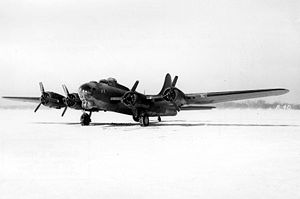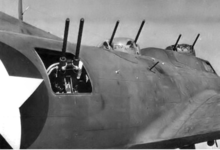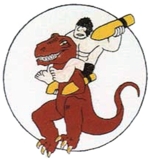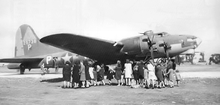Boeing YB-40 Flying Fortress Video - Picture

|
|
Boeing YB-40 Flying Fortress
Boeing YB-40 Flying Fortress

Picture - The prototype XB-40 was modified by Lockheed Vega (Project V-139) by converting the second production B-17F-1-BO (S/N 41-24341).
Role: Strategic Bomber
Manufacturer: Lockheed-Vega
First flight: September 1942
Introduced: 29 May 1943
Retired: October 1943
Primary user: United States Army Air Force
Number built: 25
Developed from: B-17 Flying Fortress

Picture - Close-up of the array of 50-cal guns on the Boeing YB-40 Flying Fortress
The Boeing YB-40 Flying Fortress was a modification of the United States B-17 Flying Fortress bomber aircraft, converted to act as a heavily-armed escort for other bombers during World War II. At the time of its development, long-range fighter aircraft such as the P-51 Mustang were just entering quantity production, and thus were not yet available to accompany bombers all the way from England to Germany and back.
Development
Work on the prototype, Project V-139, began in September, 1942 by converting the second production B-17F-1-BO (serial number 41-24341) built. Conversion work was done by Lockheed's Vega company.
The aircraft differed from the standard B-17 in that a second dorsal turret was installed in the former radio compartment, just behind the bomb bay and forward of the ventral ball turret's location; the single .50-calibre (12.7 mm) Browning machine gun at each waist station was replaced by two mounted side-by-side, with a mount for each pair of these being very much like the tail gun setup in general appearance; and the bombardier's equipment was replaced with two .50-calibre machine guns in a Bendix designed "chin" turret. The existing "cheek" machine guns (on the sides of the forward fuselage at the bombardier station), initially removed from the configuration, were restored in England to provide a total of sixteen guns, and the bomb bay was converted to an ammunition magazine. Additional armor plating was installed to protect crew positions. The aircraft's gross weight was some 4000 pounds greater than a fully-armed B-17. An indication of the burden this placed on the YB-40 is that while the B-17F on which it was based was rated to climb to 20,000 feet in 25 minutes, the YB-40 was rated at 48 minutes. Part of the decreased performance was due to the weight increase, and part was due to the greater aerodynamic drag of the gun stations.
The first flight of the XB-40 was on 10 November 1942. The first order of 13 YB-40s was made in October 1942. A follow-up order for 12 more was made in January, 1943. The modifications were performed by Douglas Aircraft at their Tulsa, Oklahoma center, and the first aircraft were completed by the end of March, 1943. Twenty service test aircraft were ordered, Vega Project V-140, as YB-40 along with four crew trainers designated TB-40. Because Vega had higher priority production projects, the YB-40/TB-40 assembly job was transferred to Douglas. A variety of different armament configurations was tried. Some YB-40s were fitted with four-gun nose and tail turrets. Some carried cannon of up to 40-mm in calibre, and a few carried up to as many as 30 guns of various calibres in multiple hand-held positions in the waist as well as in additional power turrets above and below the fuselage.
Operations

Picture - World War II emblem of the 327th Bombardment Squadron, featuring characters from the Alley Oop comic strip
The YB-40's mission was to provide a heavily-gunned escort capable of accompanying bombers all the way to the target and back. Of the initial order of 13, one (43-5732) got lost on the delivery flight from Iceland to UK in May 1943; it force-landed in a peat bog on an offshore Scottish island after running out of fuel. Although removed to Stornoway and repaired, it never flew in combat. The remaining 12 were allocated to the 92d Bombardment Group (Heavy), being assigned to the 327th Bombardment Squadron, stationed at RAF Alconbury (AAF-102) on 8 May 1943.
YB-40s flew in the following operational missions:
29 May 1943 - attacked submarine pens and locks at Saint-Nazaire. Smaller strikes were made at Rennes naval depot and U-boat yards at La Pallice. In the attack 7 YB-40s were dispatched to Saint-Nazaire; they were unable to keep up with B-17s on their return from the target and modification of the waist and tail gun feeds and ammunition supplies was found to be needed. The YB-40s were sent to Technical Service Command at the Abbots Ripton 2nd Strategic Air Depot for modifications.
15 June 1943 - 4 YB-40s were dispatched from Alconbury in a raid on Le Mans after completion of additional modifications.
22 June 1943 - attack on the I.G. Farben Industrie Chemische Werke synthetic rubber plant at Hx¼ls. The plant, representing a large percentage of the Germany's synthetic rubber producing capacity, is severely damaged. In the raid 11 YB-40s were dispatched; aircraft 42-5735 was lost, being first damaged by flak. and later shot down by Uffz. Bernhard Kunze in an FW-190A-4 of JG 1/1 over Pont, Germany. The ten crew members survived and were taken prisoner.
25 June 1943 - attack on Blohm & Voss sub shops at Oldenburg. This was the secondary target, as the primary at Hamburg was obscured by clouds. In this raid 7 YB-40’s were dispatched, of which two aborted. Two German aircraft were claimed as destroyed.
26 June 1943 - scheduled but aborted participation in attack on the Luftwaffe air depot at Villacoublay, France (primary target) and also the Luftwaffe airfield at Poissy, France. The 5 YB-40s assigned to the attack were unable to form up with the bombing squadron, and returned to base.
28 June 1943 - attack on the U-boat pens at Saint-Nazaire. In the raid the only serviceable lock entrance to the pens was destroyed. In this attack 6 YB-40’s were dispatched, and one German aircraft was claimed as destroyed.
29 June 1943 - scheduled participation in attack on the Luftwaffe air depot at Villacoublay, but aircraft returned to Alconbury due to clouds obscuring the target. In the raid 2 YB 40’s dispatched, 1 aborted.
4 July 1943 - attacks on aircraft factories at Nantes and Le Mans, France. In these raids 2 YB-40s were dispatched to Nantes and 1 to Le Mans.
10 July 1943 - attack on Caen/Carpiquet airfield. In this raid 5 YB-40s were dispatched.
14 July 1943 - attacked Luftwaffe air depot at Villacoublay. In this raid 5 YB-40s were dispatched.
17 July 1943 - YB-40s recalled from a raid on Hannover due to bad weather. In this raid 2 YB-40s were dispatched.
24 July 1943 - YB-40s recalled from an attack on on Bergen, Norway due to cloud cover. In this raid 1 YB-40 was dispatched.
28 July 1943 - attack on the Fiesler aircraft factory at Kassel. In this raid 2 YB-40s were dispatched.
29 July 1943 - attack on U-boat yards at Kiel. In this raid 2 YB-40s were dispatched.
Summary

Picture - Boeing YB-40 Flying Fortress, 42-5736 ("Tampa Tornado") on display at RAF Kimbolton, England, Oct 2, 1943 when it was shown to those attending a party for local children.
Altogether of the 59 aircraft dispatched, 48 sorties were credited. Five German fighter kills and 2 probables (likely kills) were claimed, and one YB-40 was lost, shot down on the June 22 mission to Hx¼ls, Germany. Tactics were revised on the final five missions by placing a pair of YB-40s in the lead element of the strike to protect the mission commander.
Overall the concept proved a failure because the YB-40 could not keep up with standard B-17Fs, particularly after they had dropped their bombs. Despite the failure of the project as an operational aircraft, it led directly to modifications conspicuous on the final production variant of the B-17, the B-17G:
Chin turret (also incorporated on "final production" models of the B-17F aircraft)
Offset waist gun positions
Improved tail gunner station, usually nicknamed the "Cheyenne", after the Cheyenne modification center.
Once the test program ended, most of the surviving aircraft returned to the United States in November 1943 and were used as trainers. 42-5736 ("Tampa Tornado") was flown to RAF Kimbolton on 2 October 1943 where it was put on display and later used as a group transport It was returned to the United States on 28 March 1944. All of the aircraft were sent to reclamation, mostly at RFC Ontario in May 1945, being broken up and smelted. (A couple of the YB-40s can be seen in the 1946 movie The Best Years of Our Lives, in the famous scene shot at the Ontario 'graveyard'.) No airframes were sold on the civil market.
Operators
United States
United States Army Air Force
XB-40: Conversion of B-17F-1-BO 41-24342 (Not deployed to ETO) YB-40: Conversions of B-17F-10-VE 42-5732; 5733, "Peoria Prowler"; 5734, "Seymour Angel"; 5735, "Wango Wango"; 5736, "Tampa Tornado"; 5737, "Dakota Demon"; 5738, "Boston Tea Party"; 5739, "Lufkin Ruffian"; 5740, "Monticello"; 5741, "Chicago"; 5742, "Plain Dealing Express"; 5743, "Woolaroc"; 5744, "Dollie Madison" (All deployed to ETO) YB-40: Conversions of B-17F-35-VEs 42-5920, 5921, 5923, 5924, 5925, and 5927 (Not deployed to ETO) TB-40: Conversions of B-17F-25-VEs 42-5833 and 5834; B-17F-30-VE 42-5872, and B-17F-35-VE 42-5926 (5833 deployed to ETO, but not used in combat; remainder remained in the United States).
Specifications (YB-40)
General characteristics
Crew: 10
Length: 74 ft 9 in (22.6 m)
Wingspan: 103 ft 9 in (31.4 m)
Height: 19 ft 1 in (5.8 m)
Wing area: 1,527 ft² (141.9 m²)
Empty weight: 54,900 lb (24,900 kg)
Loaded weight: 63,500 lb (28,800 kg)
Max takeoff weight: 74,000 lb (34,000 kg)
Powerplant: 4x— Wright R-1820-65 turbosupercharged radial engines, 1,200 hp (895 kW) each
Performance
Maximum speed: 292 mph (470 km/h)
Cruise speed: 196 mph (315 km/h)
Range: 2,260 mi (3,640 km)
Service ceiling: 29,200 ft (8,900 m)
Rate of climb: ft/min (m/s)
Wing loading: 47.2 lb/ft² (231 kg/m²)
Power/mass: 0.066 hp/lb (0.11 kW/kg)
Armament
Guns: 18 (or more) x— .50 in (12.7 mm) Browning M2 machine guns. Typically used 14-16, with room for up to 30.
Related development
B-17 Flying Fortress
XB-41 Liberator
Boeing-Lockheed Vega XB-40 Flying Fortress Fact Sheet, USAF
Freeman, Roger A. (1990). The Mighty Eighth War Diary. ISBN 0-87938-495-6.
Freeman, Roger A. (1991). The Mighty Eighth War Manual. pp. 154-155. ISBN 0-87938-513-8.
Bishop, Cliff T. (1986). Fortresses of the Big Triangle First. pp. 69, 73, 246-247. ISBN 1-869987-00-4.
Encyclopedia of American Aircraft
Boeing YB-40 Flying Fortress Pictures
Living Warbirds: The best warbirds DVD series.
Source: WikiPedia